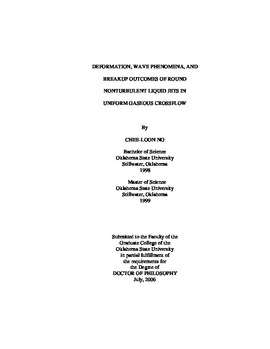| dc.contributor.advisor | Sallam, Khaled A. | |
| dc.contributor.author | Ng, Chee-Loon | |
| dc.date.accessioned | 2013-12-10T18:05:20Z | |
| dc.date.available | 2013-12-10T18:05:20Z | |
| dc.date.issued | 2006-07 | |
| dc.identifier.uri | https://hdl.handle.net/11244/7812 | |
| dc.description.abstract | Scope and Method of Study: An experimental and computational research is performed to study the deformation and breakup of round nonturbulent liquid jets in uniform gaseous crossflow. Pulsed photography and shadowgraphy in conjunction with high-speed imaging were used to study the wave phenomena and the droplets properties/transport dynamics of a nonturbulent liquid jet injected into a uniform crossflow within the bag breakup regime. The computational study extended the previous two-dimensional study by adding the third dimension, allowing the wave properties to be modeled. The computational simulation employed the Volume of Fluid (VOF) formulation of FLUENT, and was run on a 3-processors parallel Linux cluster and P4 desktops. The validated, time-accurate, CFD simulation analyzes the surface properties of the liquid jets within the column, bag, and shear breakup regimes by considering the effects of surface tension, liquid viscosity, and crossflow Weber number at large liquid/gas density ratios (>500) and small Ohnesorge numbers (<0.1). | |
| dc.description.abstract | Findings and Conclusions: Present experimental results show that the column waves along the liquid jet are attributed to Rayleigh-Taylor instabilities and the nodes layout per bag affected the breakup mechanisms of the bags. Three distinctive sizes of droplets were produced in the bag breakup regime. The size of bag-droplets normalized by the nozzle exit diameter was constant. The different trajectories for bag- and node-droplets suggested that separation of bag- and node-droplets is possible. The computational results included jet deformations, jet cross-sectional area, jet velocity, wake velocity defect, wake width, and wavelengths of column and surface waves. Present computational results yielded a similarity solution for the inner wake region. In bag breakup, the lower pressure along the sides of the jet pulled the liquid away from both the upwind and downwind surfaces of the liquid cross-section. In shear breakup, the flattened upwind surface pushed the liquid towards the two sides of the jet. In bag breakup, the flow field inside the liquid jet consisted of a counter-rotating vortex pair that was not observed in column and shear breakup. Finally, Phenomenological analyses were effective to understand the conditions for breakup regime transitions. | |
| dc.format | application/pdf | |
| dc.language | en_US | |
| dc.rights | Copyright is held by the author who has granted the Oklahoma State University Library the non-exclusive right to share this material in its institutional repository. Contact Digital Library Services at lib-dls@okstate.edu or 405-744-9161 for the permission policy on the use, reproduction or distribution of this material. | |
| dc.title | Deformation, wave phenomena, and breakup outcomes of round nonturbulent liquid jets in uniform gaseous crossflow | |
| dc.contributor.committeeMember | Moretti, Peter M. | |
| dc.contributor.committeeMember | Arena, Andrew S. | |
| dc.contributor.committeeMember | Johannes, Arland H. | |
| osu.filename | Ng_okstate_0664D_1917.pdf | |
| osu.accesstype | Open Access | |
| dc.type.genre | Dissertation | |
| dc.type.material | Text | |
| thesis.degree.discipline | Mechanical and Aerospace Engineering | |
| thesis.degree.grantor | Oklahoma State University | |
